Great Bustard Profile
About 30 million years ago, around the time whales began identifying as either baleen or toothed, a new group of birds emerged in Africa. Omnivorous, heavy, and fast-running, they trotted out of the continent, entering Europe about 25 million years before the first humans arrived.
Unfortunately, they are now endangered by the continued mess we’re making of the place, and one of the heaviest of the lot is now a necessary focus of conservation in Europe.
With a name like a Glaswegian insult, the great bustard is an old and endangered heavyweight found across Eurasia.
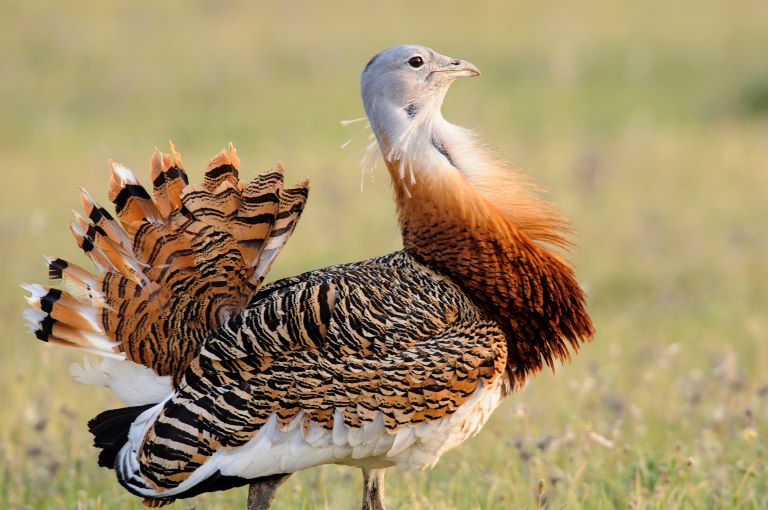
Great Bustard Facts Overview
| Habitat: | Eurasian steppe, agricultural landscapes |
| Location: | Eurasia, from Portugal to Russia, into China |
| Lifespan: | Usually 10 to 15, but up to 28 years |
| Size: | 105 (3 ft 5 in) cm tall |
| Weight: | Up to 21 kg (46 lb) |
| Colour: | Brown on top, white below, grey wings and head |
| Diet: | Plants, invertebrates, seeds |
| Predators: | Raptors, corvids, foxes, mustelids, rats, pigs |
| Top Speed: | More than 48 km/h (30 mph) on foot |
| No. of Species: | 1 |
| Conservation Status: | Endangered (IUCN) |
The Great Bustard is a fine bird, large, dense, and fluffy with barred feathers and a confident strut. It’s an ancient native to the landmass from Europe and the Far East and is a top contender for the title of heaviest flying bird.
Despite its impressive bulk, this is a fast bird, and can often outpace a fox, though not always.
Their mating calls are a curious mix of grunts and fart sounds, and their range has been heavily reduced by the conversion of land. Of those that remain, most now live in Portugal, and who could blame them for that?
Interesting Great Bustard Facts
1. They’re heavy
Bustards are heavy birds, and the great bustard is probably the heaviest. As far as flying birds, there might not be a bird quite so rotund and dense as this one and a large male might weigh upwards of 18 kg.
The heaviest on record was a whopping 21 kg, which is higher than any other flying bird recorded. This is definitely up there with such heavyweights as the Andean condor and trumpeter swans, but possibly the closest competitor for the title is the Kori bustard, its closest relative.
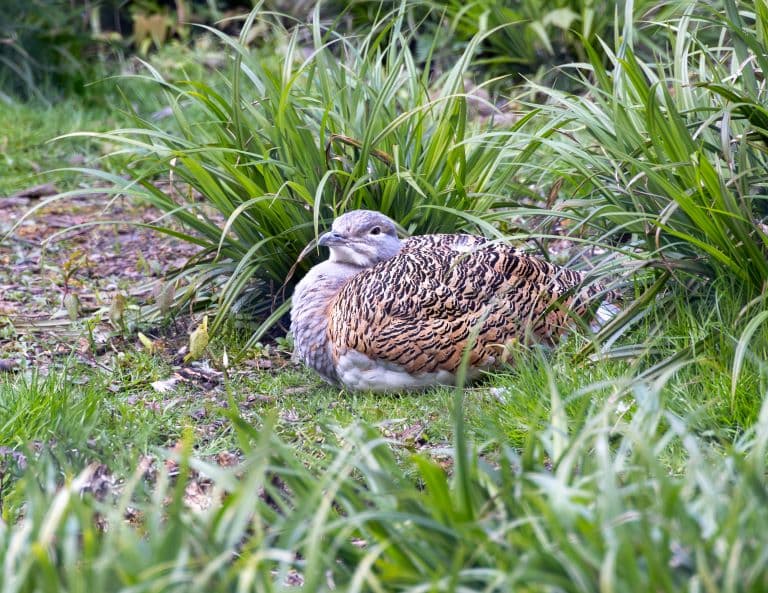
2. Males are heavier than females
While males may be the heaviest flying birds, the females certainly bring down the average in this species. That’s because the great bustards are one of the most sexually dimorphic species of bird there is.
Sexual dimorphism is essentially the significant phenotypical differences between the males and females of a species. In birds, it’s often based on colour, but size is another common difference, and in the great bustard, this is the more significant of the two.
Males great bustards can weigh almost 2.5 times that of the females, which is the second-most dimorphic of any species, after the green peafowl, whose males can be four times the mass of the females.
Despite this size difference, great bustards can really move.
3. But they can be fast
This species is said to be about to outrun a fox, which is where their estimated speed of 48 km/h comes from. And they do this on foot, rather than flying.
Bustards can fly, but they’re better adapted to terrestrial life, so choose to sprint out of danger in most cases.
This doesn’t always work out for them, and at least two of a reintroduced group of great bustards to the UK met their end at the teeth of a fox.
Around 70% of chicks die in their first year, so it could be argued that fox predation is an important selective pressure to maintain the fitness of the bustard populations, and conservationists must allow this balance while making sure enough survive to keep a healthy gene pool.
But there’s a learning element, too. Animals have culture and are not purely instinctive automatons as we once assumed.
So, it’s important to train chicks to fear foxes. In the case of the UK reintroduction, this was done by squirting them with water and wind jets when they didn’t seem to show an aversion to the predators.
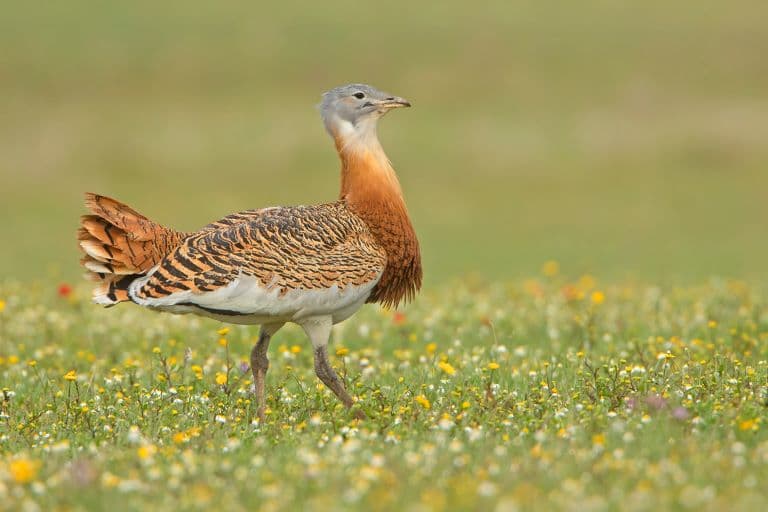
4. They fart
Among the many calls this bird makes while fluffing itself up on the plains, there’s a distinctive and familiar raspberry noise that comes out of it.
Both sexes are pretty mute most of the time, but when they do decide to chatter, they have a range of grunts, twitterers and trills that signify various moods.
It’s not clear what the farting is for, but it is pretty funny. 1
5. Most of them are in Portugal
The reason there’s a reintroduction program in Britain is that the country is starting to realise just how much historical damage it did to the local wildlife population and would like to have another go at it. Bustards were driven to extinction in the UK, and the last one was shot in 1832.
But it’s not just Britain, much of its previous range has seen habitats converted or destroyed, and today, the majority of the great bustards are found in Portugal.
60% of all the great bustards in the world are enjoying the Algarve in the off-season and visiting Christian Ronaldo’s house.
These birds thrive best in places with few people, as they nest on the ground. They also require adequate food. 2
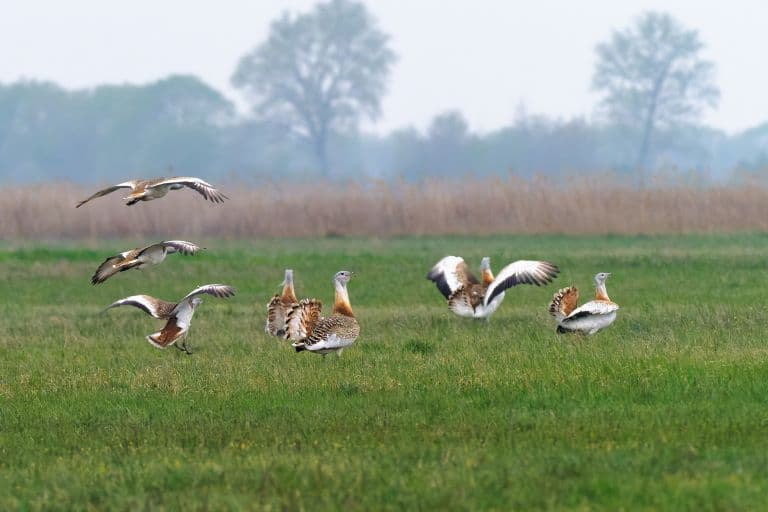
6. They need a lot of insects
The prospects for this species are determined by whether we as humans can dedicate large areas of land that are free from disturbance and packed with an abundance of insects.
Ground nesting birds are so vulnerable to invasive species such as cats and dogs, but our over-zealous use of pesticides has seen a steep decline in invertebrates, too, and these are associated with the breeding success of great bustards.
Finally, as big, chunky ground birds, they’re quite easily hunted, and this is a big no-no for an endangered species.
The trouble is, the vast open landscapes it needs are hard to monitor. Even today, hunting remains a significant contributor to the decline of the species. 3
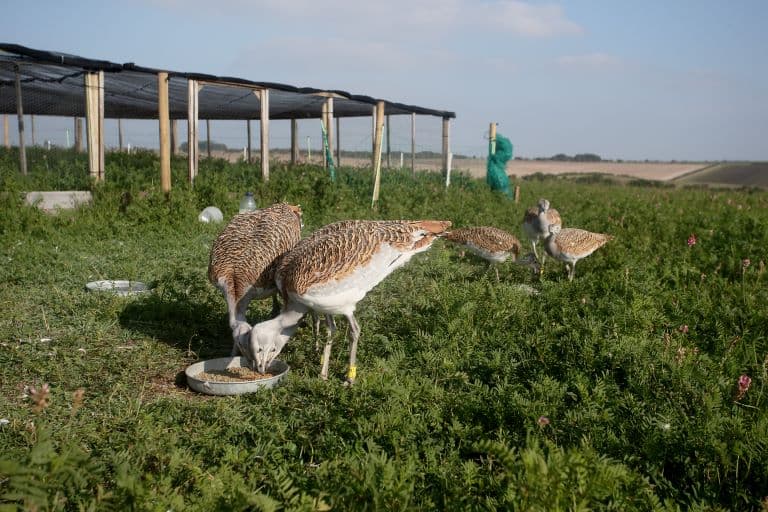
Great Bustard Fact-File Summary
Scientific Classification
| Kingdom: | Animalia |
| Phylum: | Chordata |
| Class: | Aves |
| Order: | Oditiformes |
| Family: | Oditidae |
| Genus: | Otis |
| Species: | tarda |
Fact Sources & References
- Birds_Sound (2023), “Great bustard”, YouTube.
- “Great Bustard-Birding Day Tour”, becool travel.
- “Great Bustard”, IUCN Red List.
